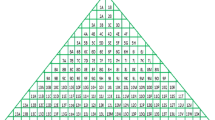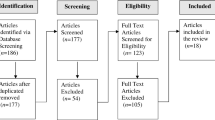Abstract
This critical review examined a series of 10 controlled studies in which traditional operant behavioral procedures were compared with more recently developed normalized interventions for teaching language to young children with autism. Main characteristics of the older treatments include highly structured direct teaching sessions of discrete trials, teacher initiation, artificial reinforcers, and response shaping. Normalized interventions consist of loosely structured sessions of indirect teaching with everyday situations, child initiation, natural reinforcers, and liberal criteria for presentation of reinforcers. The main conclusion was that in all eight studies with language criterion responses, normalized language training was more effective than discrete-trial training. Furthermore, in both studies that assessed parental affect, normalized treatment yielded more positive affect than discrete-trial training.
Similar content being viewed by others
REFERENCES
American Psychiatric Association. (1987). Diagnostic and statistical manual of mental disorders (3rd ed., revised). Washington, DC: Author.
American Psychiatric Association. (1994). Diagnostic and statistical manual of mental disorders (4th ed.). Washington, DC: Author.
Anderson, S. R., Avery, D. L., DiPietro, E. K., Edwards, G. L. & Christian, W. P. (1987). Intensive home-based early intervention with autistic children. Education and Treatment of Children, 10, 352-366.
Birnbrauer, J. S., & Leach, D. J. (1993). The Murdoch Early Intervention Program after 2 years. Behaviour Change, 10, 63-74.
Carr, E. G., & Kologinsky, E. (1983). Acquisition of sign language by autistic children II: Spontaneity and generalization effects. Journal of Applied Behavior Analysis, 16, 297-314.
Dawson, G., & Osterling, J. (1996). Early intervention in autism. In M. J. Guralnick (Ed.), The effectiveness of early intervention: Second generation research (pp. 307-326). Baltimore, MD: Paul H. Brookes.
Fenske, E. C., Zalenski, S., Krantz, P. J., & McClannahan, L. E. (1985). Age at intervention and treatment outcome for autistic children in a comprehensive intervention program. Analysis and Intervention in Developmental Disabilities, 5, 49-58.
Ferster, C. B. (1967). Arbitrary and natural reinforcement. Psychological Record, 17, 341-347.
Goetz, L., Schuler, A., & Sailor, W. (1983). Motivational considerations in teaching language to severely handicapped students. In M. Hersen, V. Van Hasselt, & J. Matson (Eds.), Behavior therapy for the developmentally and physically disabled (pp. 57-77). New York: Academic Press.
Harris, S. L. (1975). Teaching language to nonverbal children-with emphasis on problems of generalization. Psychological Bulletin, 82, 565-580.
Harris, S. L., Handleman, J. S., Gordon, R., Kristoff, B., & Fuentes, F., (1991). Changes in cognitive and language functioning of preschool children with autism. Journal of Autism and Developmental Disorders, 21, 281-290.
Hart, B. M., & Risley, T. R. (1968). Establishing use of descriptive adjectives in the spontaneous speech of disadvantaged preschool children. Journal of Applied Behavior Analysis, 1, 109-120.
Hart, B., & Risley, T. R. (1974). Using preschool materials to modify the language of disadvantaged children. Journal of Applied Behavior Analysis, 7, 243-256.
Hart, B., & Risley, T. R. (1975). Incidental teaching of language in the preschool. Journal of Applied Behavior Analysis, 8, 411-420.
Hart, B. M., & Risley, T. R. (1982). How to use incidental teaching for elaborating language. Lawrence, KS: H & H Enterprises.
Holmes, P. A., Smith, J. M., Thomas, J. L., & Delprato, D. J. (1999, May). Needs analysis of families with autistic children. In P. M. Meinhold (Chair), Childhood autism: Needs analysis, education and training, and field assessment. Symposium conducted at the meeting of the Association for Behavior Analysis, Chicago, IL.
Kent, R. D. (1993). Speech intelligibility and communicative competence in children. In A. P. Kaiser & D. B. Gray (Eds.), Enhancing children's communication: Research foundations for intervention (pp. 223-239). Baltimore, MD: Paul H. Brookes.
Koegel, R. L., Bimbela, A., & Schreibman, L. (1996). Collateral effects of parent training on family interactions. Journal of Autism and Developmental Disorders, 26, 347-359.
Koegel, R. L., Camarata, S., Koegel, L. K., Ben-Tall, A., & Smith, A. E. (1998). Increasing speech intelligibility in children with autism. Journal of Autism and Developmental Disorders, 28, 241-251.
Koegel, R. L., Koegel, L. K., & Surratt, A. (1992). Language intervention and disruptive behavior in preschool children with autism. Journal of Autism and Developmental Disorders, 22, 141-153.
Koegel, R. L., O'Dell, M., & Dunlap, G. (1988). Producing speech use in nonverbal autistic children by reinforcing attempts. Journal of Autism and Developmental Disorders, 18, 525-538.
Koegel, R. L., O'Dell, M. C., & Koegel, L. K. (1987). A natural language teaching paradigm for nonverbal autistic children. Journal of Autism and Developmental Disorders, 17, 187-200.
Koegel, R. L., Rincover, A., & Egel, A. L. (1982). Educating and understanding autistic children. San Diego, CA: College-Hill Press.
Koegel, R. L., Russo, D. C., & Rincover, A. (1977). Assessing and training teachers in the generalized use of behavior modification with autistic children. Journal of Applied Behavior Analysis, 10, 197-205.
Koegel, R. L., Schreibman, L., Good, A., Cerniglia, L., Murphy, C., & Koegel, L. K., (1989). How to teach pivotal behaviors to children with autism: A training manual. Santa Barbara, CA: University of California, Santa Barbara.
Koegel, R. L., & Williams, J. A. (1980). Direct versus indirect response-reinforcer relationships in teaching autistic children. Journal of Abnormal Child Psychology, 8, 537-547.
Laski, K. E., Charlop, M. H., & Schreibman, L. (1988). Training parents to use the natural language paradigm to increase their autistic children's speech. Journal of Applied Behavior Analysis, 21, 391-400.
Lonigan, C. J., Elbert, J. C., & Johnson, S. B. (1998). Empirically supported psychosocial interventions for children: An overview. Journal of Clinical Child Psychology, 27, 138-145.
Lovaas, O. I. (1977). The autistic child: Language development through behavior modification. New York: Irvington.
Lovaas, O. I. (1981). Teaching developmentally disabled children: The me book. Austin, TX: PRO-ED.
Lovaas, O. I. (1987). Behavioral treatment and normal educational and intellectual functioning in young autistic children. Journal of Consulting and Clinical Psychology, 55, 3-9.
Maurice, C., Green, G., & Luce, S. C. (1996). Behavioral intervention for young children with autism. Austin, TX: PRO-ED.
McEachin, J. J., Smith, T., & Lovaas, O. I. (1993). Long-term outcome for children with autism who received early intensive behavioral treatment. American Journal on Mental Retardation, 97, 359-372.
McGee, G. G., Krantz, P. J., Mason, D., & McClannahan, L. E. (1983). A modified incidental procedure for autistic youth: Acquisition and generalization of receptive object labels. Journal of Applied Behavior Analysis, 16, 329-338.
McGee, G. G., Krantz, P. J., & McClannahan, L. (1985). The facilitative effects of incidental teaching on preposition use by autistic children. Journal of Applied Behavior Analysis, 18, 17-31.
Nathan, P. E., & Gorman, J. M. (1998). A guide to treatments that work. New York: Oxford University Press.
Neef, N. A., Walters, J., & Egel, A. L. (1984). Establishing generative yes/no responses in developmentally disabled children. Journal of Applied Behavior Analysis, 17, 453-460.
Risley, T. R., & Wolf, M. M. (1967). Establishing functional speech in echolalic children. Behaviour Research and Therapy, 5, 73-88.
Ritvo, E. R., & Freeman, B. J. (1978). National Society for Autistic Children definition of the syndrome of autism. Journal of Autism and Childhood Schizophrenia, 8, 162-167.
Rogers, S. J. (1998). Empirically supported comprehensive treatments for young children with autism. Journal of Clinical Child Psychology, 27, 168-179.
Schreibman, L., Kaneko, W. M., & Koegel, R. L. (1991). Positive affect of parents of autistic children: A comparison across two teaching techniques. Behavior Therapy, 22, 479-490.
Sheinkopf, S. J., & Siegel, B. (1998). Home-based behavioral treatment of young children with autism. Journal of Autism and Developmental Disabilities, 28, 15-23.
Simeonsson, R. J., Olley, J. G., & Rosenthal, S. L. (1987). Early intervention for children with autism. In M. J. Guralnick & F. C. Bennett (Eds.), The effectiveness of early intervention for atrisk and handicapped children (pp. 275-296). San Diego, CA: Academic Press.
Smith, T., Eikeseth, S., Klevstrand, M., & Lovaas, O. I. (1997). Intensive behavioral treatment for preschoolers with severe mental retardation and pervasive developmental disorder. American Journal on Mental Retardation, 102, 238-249.
Task Force on Promotion and Dissemination of Psychological Procedures. (1995). Training in and dissemination of empirically validated psychosocial treatments: Report and recommendations. The Clinical Psychologist, 48, 3-23.
Williams, J. A., Koegel, R. L., & Egel, A. L. (1981). Response-reinforcer relationships and improved learning in autistic children. Journal of Applied Behavior Analysis, 14, 53-60.
Wolf, M. M., Risley, T. R., & Mees, H. (1964). Application of operant conditioning procedures to the behaviour problems of an autistic child. Behaviour Research and Therapy, 1, 305-312.
Author information
Authors and Affiliations
Rights and permissions
About this article
Cite this article
Delprato, D.J. Comparisons of Discrete-Trial and Normalized Behavioral Language Intervention for Young Children with Autism. J Autism Dev Disord 31, 315–325 (2001). https://doi.org/10.1023/A:1010747303957
Issue Date:
DOI: https://doi.org/10.1023/A:1010747303957




